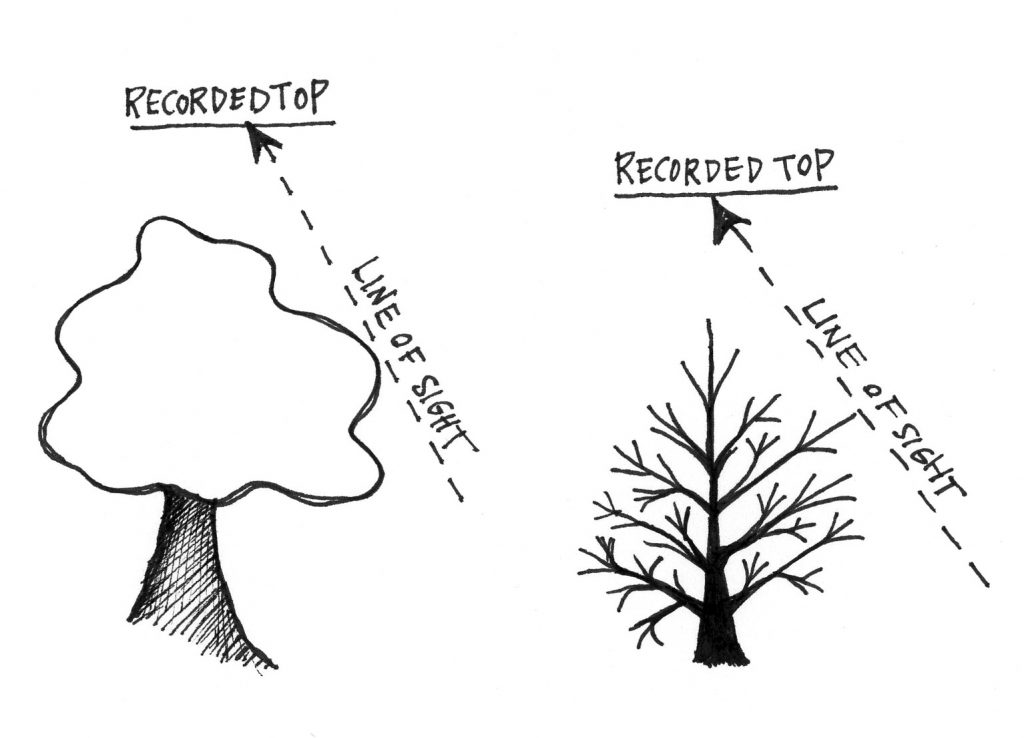7 2.3 Using Percent Slope to Determine Tree Height
To determine tree height, the run and slope are measured, then used to calculate the rise (Figure 2.3).
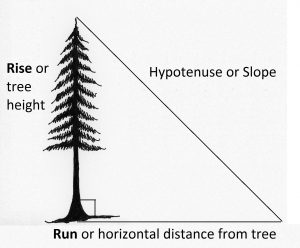
[latex]\displaystyle \left( {\frac{{rise}}{{run}}} \right)\left( {100} \right)=[/latex]%slope
Solve the %slope equation for rise as follows:
1. Multiply both sides of the equation by run to cancel out run on the left side of the equation
[latex]\displaystyle \frac{{\left( {run} \right)\left( {rise} \right)\left( {100} \right)}}{{run}}=[/latex](run)(%slope)
2. Divide both sides by 100 to cancel out 100 on the left side of the equation
[latex]\displaystyle ~\frac{{\left( {rise} \right)\left( {100} \right)}}{{100}}=\frac{{\left( {run} \right)}}{{100}}[/latex](%slope)
That leaves the following equation:
[latex]\displaystyle rise=\frac{{\left( {run} \right)}}{{100}}[/latex](%slope) where rise =height
Notice that the %slope multiplier (100) becomes the denominator. This remains a constant. The run and %slope values are measurements, so they will change with each tree.
Here are some examples using %slope for tree height:
Example 1:
Georgia walks out a horizontal distance of 50 feet from a tree (Figure 2.4). She looks through her clinometer to determine the %slope from her eye to the top of the tree. Looking up, she reads “+124%.” Using our formula to determine the rise:
[latex]\displaystyle rise=\frac{{\left( {run} \right)}}{{100}}[/latex](%slope)
[latex]\displaystyle rise=\frac{{\left( {50} \right)}}{{100}}[/latex](+124) = +62 or 62 feet
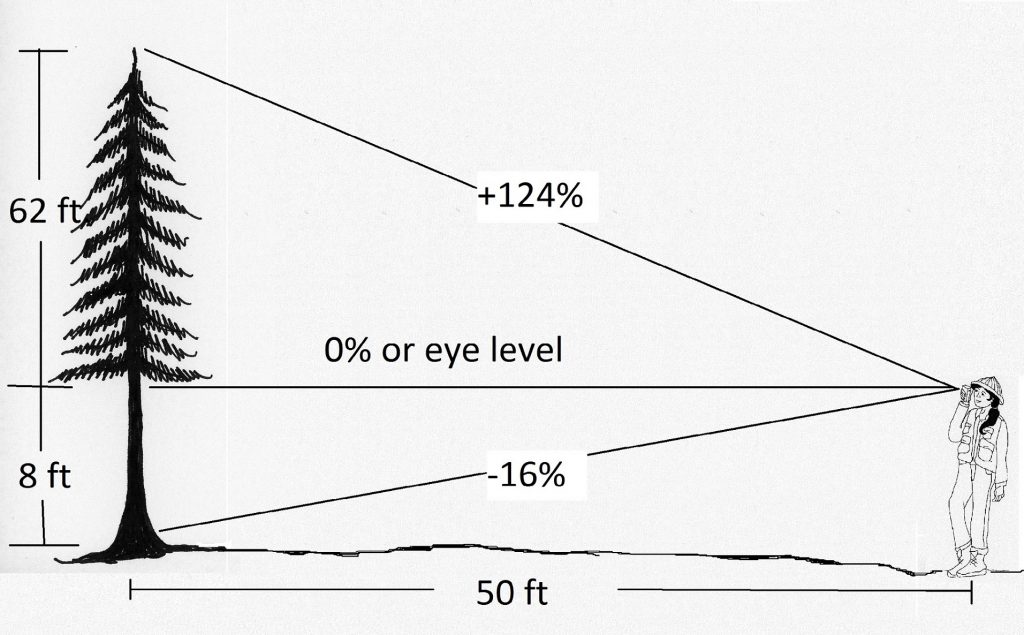
Therefore, the height of the tree from her eye to the top is 62 feet. Next, the same procedure is used to determine the height from Georgia's eye level down to the stump. Georgia takes a reading down to the stump and reads -16%.
[latex]\displaystyle rise=\frac{{\left( {run} \right)}}{{100}}[/latex](%slope)
[latex]\displaystyle rise=\frac{{\left( {50} \right)}}{{100}}[/latex](-16) = -8 or 8 feet
Georgia measured 62 feet from her eye to the top of the tree, and 8 feet from her eye to the stump of the tree. Add those two measures together to get the total height of the tree.
62 ft (top) + 8 ft (base) = 70 ft.
Remember that a negative slope measurement simply means you are looking downhill. It is important to recognize that the -8 feet is a drop in elevation, not a negative value.
The two calculations can be done in one step as follows:
[latex]\displaystyle rise=\frac{{\left( {run} \right)}}{{100}}[/latex](%slope)
[latex]\displaystyle rise=\frac{{\left( {50} \right)}}{{100}}[/latex](124+16) = 70 or 70 feet
Notice Georgia put “+16” in the formula, even though the reading to the stump was a negative number. She wants to add in the height of the tree below her eye, not subtract it. Again, a negative slope simply means one is looking downhill. You have to think about your eye position in relation to the tree, and what the readings actually mean. Using %slope symbols algebraically can be misleading.
Example 2:
Tobias walks out a horizontal distance of 100 feet from the same tree (Figure 2.5). He looks to the top of the tree and reads “+62%” on his clinometer. He looks down to the stump and reads “-8.”
[latex]\displaystyle rise=\frac{{\left( {run} \right)}}{{100}}[/latex](%slope)
[latex]\displaystyle rise=\frac{{\left( {100} \right)}}{{100}}[/latex](62+8) = 70 or 70 feet
Notice that by walking farther from the tree (having a longer run), Tobias’ slope readings were smaller than Georgia’s , even though they both ended up with the same height. The angles at which Tobias was looking at the tree were smaller.
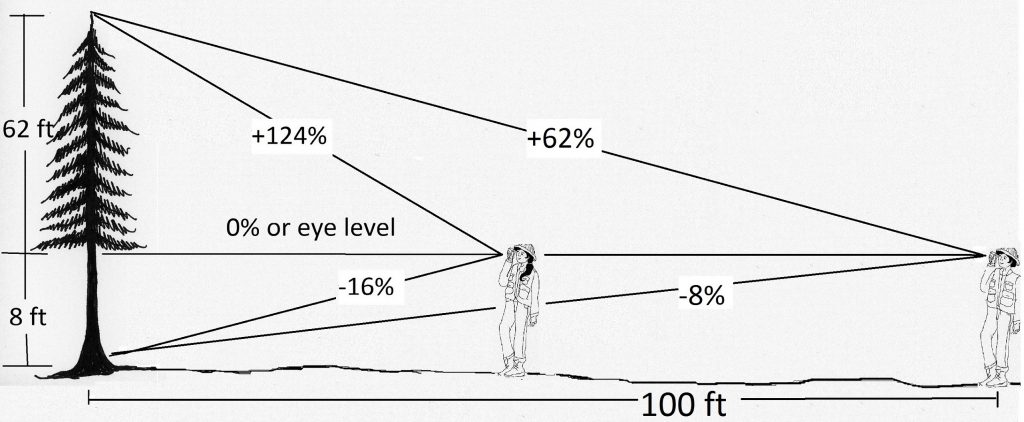
Also notice that when Tobias walked out 100 feet from the tree, his run equaled the denominator, 100, cancelling it out and leaving the tree equal to the readings from the clinometers. This “shortcut” makes it much easier and faster to determine tree height by reducing the number of conversions that have to be made.
[latex]\displaystyle rise=\frac{{\left( {100} \right)}}{{100}}[/latex](62+8) = 70 or 70 feet
What happens at a horizontal distance of 150 feet? The slope readings are even smaller.
[latex]\displaystyle rise=\frac{{\left( {run} \right)}}{{100}}[/latex](%slope)
[latex]\displaystyle rise=\frac{{\left( {150} \right)}}{{100}}[/latex](42+5) = 70 or 70 feet
Thus, the farther one walks from a tree, the better the perspective for seeing the tree top. Being too close to the tree can result in an obscured top, as side branches will be in the way (Figures 2.6 and 2.7).
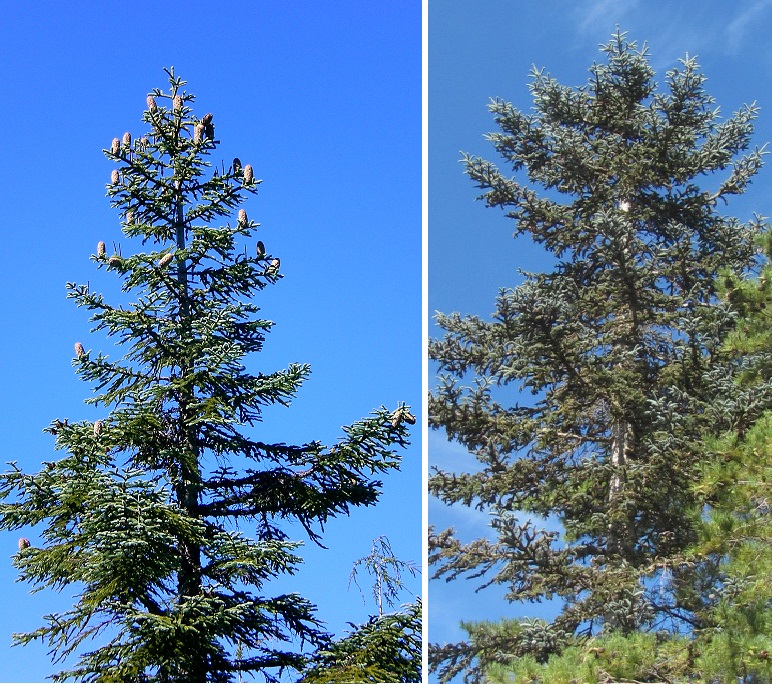
In the photo on the left, the tree’s top can be seen clearly. The tip is distinguishable from the top side branches. The right photo however, illustrates a foreshortened view of the top where side branches could be mistaken for the top. If a %slope reading is taken on side branches thought to be the true top, the tree's height can be overestimated as shown in Figure 2.7.
